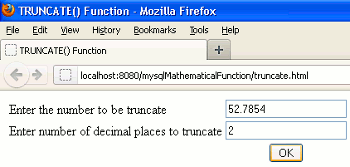In this tutorial you will learn about how to use the truncate() function of mysql math function with java servlet
MySql TRUNCATE() Function Example using Java Servlet
In this tutorial you will learn about how to use the truncate() function of mysql math function with java servlet
TRUNCATE() function in mysql limits the number right of the decimal point passed as first argument to a specified number passed as second argument. According to the signature of this function if the number i.e. second argument which specifies the number upto how many decimal places the actual number have to be limited is not defined then the default value will be determined 0 and in such case the actual number i.e. first argument will be returned by recognizing no fractional part i.e. the left digits of the decimal point of an actual value will be returned.
Syntax :
truncate(num, dnum);
Here the argument 'num' is an actual number which have to be limited / truncated right of the 'dnum' decimal places and the argument 'dnum' is a number which specifies upto how many decimal places the 'num' has to be truncated.
Now, since I have to use this function in java servlet program, therefore I have created a java servlet class named MysqlTruncateServlet which extends the HttpServlet class. In the body of class I overridden the method doGet() and created an objects of HttpServletRequest and HttpServletResponse into its parameter. Inside the doGet() method first I set the mime type that in which format the browser will show the output. In the next line I used the getWriter() method of ServletResponse interface with the object of HttpServletResponse. HttpServletResponse interface extends this method from the ServletResponse. In Next step I am taking input using the getParameter() method of ServletRequest with the object of HttpServletRequest. In continue we have to establish a connection between java code and database system. So, since I am using Mysql in the example given below therefore, I am loading the driver of mysql and make a connection by using the getConnection() method of DriverManager class. It returns a Connection. Further I passed the query " SELECT TRUNCATE("+num+","+i+")"; (Here 'num' and 'i' are variables that stores the value given by the user in their respective textfields.) into the parameter of prepareStatement() method of Connection interface which gives an object of PreparedStatement interface. In the next line I used the executeQuery() method of PreparedStatement interface which returns a ResultSet object that holds the result of query. At last I have extracted the result from the ResultSet object.
Example :
truncate.html
<!DOCTYPE html PUBLIC "-//W3C//DTD HTML 4.01 Transitional//EN" "http://www.w3.org/TR/html4/loose.dtd"> <html> <head> <meta http-equiv="Content-Type" content="text/html; charset=ISO-8859-1"> <title>TRUNCATE() Function</title> </head> <body> <form method="get" action="MysqlTruncateServlet"> <table> <tr> <td>Enter the number to be truncate </td> <td> <input type="text" name="text1"/></td> </tr> <tr> <td>Enter number of decimal places to truncate </td> <td><input type="text" name="text2"/></td> </tr> <tr> <td></td> <td align="center"><input type="submit" value="OK"/></td> </tr> </table> </form> </body> </html>
MysqlTruncateServlet.java
import java.io.IOException;
import java.io.PrintWriter;
import java.sql.SQLException;
import java.sql.DriverManager;
import java.sql.Connection;
import java.sql.PreparedStatement;
import java.sql.ResultSet;
import javax.servlet.ServletException;
import javax.servlet.http.HttpServlet;
import javax.servlet.http.HttpServletRequest;
import javax.servlet.http.HttpServletResponse;
public class MysqlTruncateServlet extends HttpServlet
{
public void doGet(HttpServletRequest request, HttpServletResponse response)
throws IOException, ServletException
{
response.setContentType("text/html");
PrintWriter out = response.getWriter();
double num = Double.parseDouble(request.getParameter("text1"));
String dnum = request.getParameter("text2");
String className = "com.mysql.jdbc.Driver";
String url = "jdbc:mysql://192.168.10.13";
String user = "root";
String password = "root";
Connection con;
PreparedStatement ps;
ResultSet rs;
try
{
Class.forName(className);
con = DriverManager.getConnection(url, user, password);
if(dnum=="")
{
int i=0;
String sql = "SELECT TRUNCATE("+num+","+i+")";
ps = con.prepareStatement(sql);
rs= ps.executeQuery();
while(rs.next())
{
double trn = Double.parseDouble(rs.getString(1));
out.println("After truncating, the value is = "+trn);
}
}
else
{
double i = Double.parseDouble(dnum);
String sql = "SELECT TRUNCATE("+num+","+i+")";
ps = con.prepareStatement(sql);
rs = ps.executeQuery();
while(rs.next())
{
double trn = Double.parseDouble(rs.getString(1));
out.println("After truncating, the the value is = "+trn);
}
}
}
catch(SQLException sx)
{
out.println(sx);
}
catch(ClassNotFoundException cx)
{
out.println(cx);
}
}
}
web.xml
<?xml version="1.0" encoding="UTF-8"?> <web-app id="WebApp_ID" version="2.4" xmlns="http://java.sun.com/xml/ns/j2ee" xmlns:xsi="http://www.w3.org/2001/XMLSchema-instance" xsi:schemaLocation="http://java.sun.com/xml/ns/j2ee http://java.sun.com/xml/ns/j2ee/web-app_2_4.xsd"> <display-name>mysqlMathematicalFunction</display-name> <servlet> <servlet-name>MysqlTruncateServlet</servlet-name> <servlet-class>MysqlTruncateServlet</servlet-class> </servlet> <servlet-mapping> <servlet-name>MysqlTruncateServlet</servlet-name> <url-pattern>/MysqlTruncateServlet</url-pattern> </servlet-mapping> </web-app>
Output :
When you will execute the above example you will get the output as :
1.

2. When you will enter the value like below

3. You will get the output as :

4. But when you will enter the value like the below

5. You will get the output as :



[ 0 ] Comments